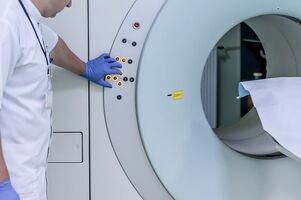Most people experience back problems from time to time and experience pain in their lower back, neck, or middle back. In fact, back pain is the most common adult physical complaint and the leading cause of temporary disability. Back pain can be mild or severe, and pain can be short-term or chronic.
Back pain includes: muscle and tendon pain, disc herniation, fracture or other back problems. Usually, the reasons have a long history. Usually, back pain is caused by diseases of the spine.

The structure of the spine is designed to bear extreme loads. The structure of the spine is stable enough for a person to walk (stand) and flexible enough to carry out body movements.
A healthy spine has an oblong S-shape when viewed from the side and has natural curves in the lumbar, thoracic and neck spine. The spine is the main bearing part of the body. In addition, the spine protects the spinal cord and spinal roots with its skeletal structure, thereby ensuring the normal functioning of organs and tissues.
Between each of the 24 vertebrae there are buffering discs.
Reason
Back pain refers to problems that a person mainly creates for himself. Back problems and back pain are often caused by bad habits that build up over a long period of time. These bad habits include:
- Poor posture
- Overvoltage during work
- Incorrect working or driving posture
- Repeated unusually strong spinal stretching or stretching or lifting weights.
The results of habits are rarely immediate, but often their negative effects build up over time. One of the most common types of back pain is pain associated with muscle tension around the spine. Most often, back pain is combined with tension, muscles that occur in the lumbar spine and the neck spine. If the muscle tension is involved in lifting heavy objects, the pain can be very severe.
Sometimes back pain happens for no apparent reason. In such cases, they talk about nonspecific back pain. Such pains can develop due to weakened muscles unable to cope with everyday stress, such as walking, bending, and stretching. In addition, such nonspecific pains can be triggered by poor sleep, general fatigue or exposure to stressful situations.
Chronic pain in myofascial pain syndrome is caused by local muscle tension. Sometimes this local muscle tension is caused by stress or other emotional problems.
Pregnancyis often the cause of the disease and this is due to hormonal changes in a woman's body and excessive weight gain and stress on the spine and legs.
Injuries in contact sports, accidents and falls can also cause back problems, from mild muscle strain to serious injuries like the spine and spinal cord.
It is important to understand that back pain is one of the symptoms of the disease and not a diagnosis. Medical conditions that can cause back pain include:
Mechanical problems: Mechanical problems involving the movement of the spine or the feeling that a person experiences while performing certain movements. The most common mechanical cause is degenerative disc disease (osteonecrosis), when abnormal changes occur in the disc and impaired function of the disc, leading to attackspain. Another cause of back pain is degenerative changes in the joints of the spine (fibrosis of the spine). Other mechanical causes include muscle spasm, muscle tension, and disc herniation.
Injuries: Spinal injuries such as sprains and fractures can cause both acute pain and chronic pain. Sprains, tears in the ligaments that support the spine, can be caused by twisting the body or improper lifting. Spina bifida is often the result of osteoporosis, a disorder in which bone density is impaired. Less common, back pain can be caused by more serious injuries from crashes and falls.
Conditions and diseases acquired. Many medical conditions can cause or contribute to pain. These include scoliosis, scoliosis, and scoliosis, which is usually painless until middle age. Types of arthritis (osteoarthritis, rheumatoid arthritis, ankylosing spondylitis), spinal stenosis, affects the nerve roots of the spinal cord. Diseases like osteoporosis on its own are painless, but can lead to spinal fractures, manifested by intense pain. Other causes of back pain include pregnancy, infection of the kidneys or urinary stones, endometriosis, fibromyalgia, which are characterized by chronic fatigue and diffuse muscle pain.
Infections and tumors. While infection is not a common cause, it can be painful. If bone tissue is affected, then we are talking about osteomyelitis, if an infection affects the disc, then we are talking about disc inflammation. Tumors are also relatively rarely painful. Sometimes tumors of the spine are primary, but most tumors have a metastatic origin and the main focus is on another part of the body.
Although the cause of back pain is often physical, it's important to understand that emotional stress can play a role in both the intensity and duration of pain. In addition, stress and emotion can affect skeletal muscle tone. So, when depressed and anxious, back pain can be more intense. In addition, insomnia or lack of sleep can contribute to or worsen pain.
Back pain is only a symptom and can be reflected. Many diseases of the peritoneum and pelvic organs can cause spinal pain (appendicitis, aneurysm, kidney disease, bladder disease, pelvic inflammatory disease and infections).
Risk Factors
- Above 40 years old
- Male gender
- Family history
- Previous injuries
- Pregnant
- Past surgical interventions
- Birth defect of the spine.
- Lack of regular exercise
- A job or activity that requires long sitting and lifting weights.
- Smoking. Smokers more often than nonsmokers experience back pain.
- Overweight. Being overweight, especially those with fat around the waist, can put more strain on your back and tend to weaken muscles and limit exercise
- Poor posture. The impaired posture leads to a disturbance in the distribution of the load vectors and causes muscle tension, muscle spasm and pain.
- Tension. Stress and other emotional factors are thought to play a major role in back pain, especially chronic pain. Many people unknowingly strain their back muscles when under stress.
- Condition after a long period of depression.
- Long-term use of drugs (such as steroids) that weaken bone tissue.
- Lung diseases that lead to a chronic cough.
Symptoms
Most people have back pain in their life. There are many reasons for back pain, some of which are self-created. Other causes include accidents, muscle sprains, sports injuries and various illnesses. Although the causes can be different, most of them are marked with the same symptoms.
- Persistent or stiff pain in any part of the spine, from the base of the neck to the coccyx
- Acute local pain in the neck, upper back, or lower back - especially after lifting heavy objects or performing strenuous activities. (Headache can also be a sign of a heart attack or other life-threatening condition. )
- Chronic pain in the middle or lower body, especially after sitting or standing for long periods of time.
- Pain in the lower back spreading to the buttocks of the legs.
- Inability to stand upright.
But there are symptoms that require medical attention
- A feeling of numbness, tingling, or weakness in the arms or legs, as this may indicate spinal cord damage.
- Lower back pain spreading to the legs, possibly evidence of root compression (rhinitis).
- Pain that is worse when coughing or leaning forward, may be a sign of a herniated disc.
- Pain accompanied by fever and burning sensation when urinating, this could be a sign of a urinary tract infection.
- Bowel or bladder dysfunction
- Cancer history
- Lose weight
- Long-term steroid use
- History of injury
- Discomfort increases even at rest.
- Pain lasting more than a month
- Night pain
- No therapeutic effect
- Medication history
Diagnosis

Since the cause of back pain can be many different conditions, it is very important first and foremost it is important to carefully collect your doctor's symptoms and pathology. Both determining the location of the pain and the intensity, the presence of irradiation is important. Physical examination includes careful examination of the neurological condition (reflexive activity, muscle strength, sensitivity, etc. ). If you suspect that you have a disease of the pelvic organs, your doctor may prescribe the consultation of a gynecologist or urologist.
Tool research method
X-rays are often of little value in diagnosing spinal pain, especially if there are no serious symptoms. The use of radiography is indicated for significant acute or minor trauma injuries in patients over 50 years of age, patients with osteoporosis, or with a long history of steroid use.
TheMRI is the most informative diagnostic method and allows for high-quality imaging of both bone and soft tissue, while also allowing the diagnosis of both degenerative and tumor changes or infections.
For a better visualization of bone changes, a CT may be recommended.
EMG and ENMG allow to determine conduction along nerve and muscle fibers and, as a rule, are used in the diagnosis of chronic back pain.
Ultrasound examines the organs in the abdomen or small pelvic organs, and the kidneys are necessary in case it is necessary to distinguish the source of the pain.
Methods of research in the laboratory are also used for the differential diagnosis of inflammatory or infectious diseases.
Treatment
There are no common treatments for back pain. Treatment of back pain in each case depends on the origin of the pain symptoms and the individual characteristics of each person, since everyone's perception is significantly different.
Medical treatments include the use of different medicines, both common pain relievers or NSAIDs, and muscle relaxants or antibiotics for infections. With chronic pain syndrome, it is possible to use antidepressants, sedatives or sedatives.

Non-pharmacological treatments such as physical therapy, massage, manual therapy, acupuncture, and exercise have been widely used in back pain treatment. These methods of treatment are effective for both acute and chronic pain associated with spinal diseases.





































